multivitamin support

free shipping over $100 (USA & Canada)
1-877-937-4372 the pet expert hotline
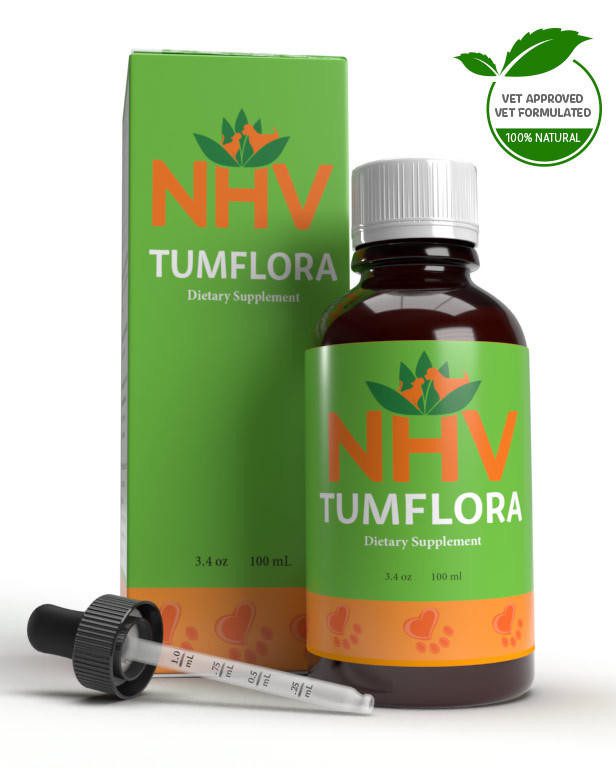
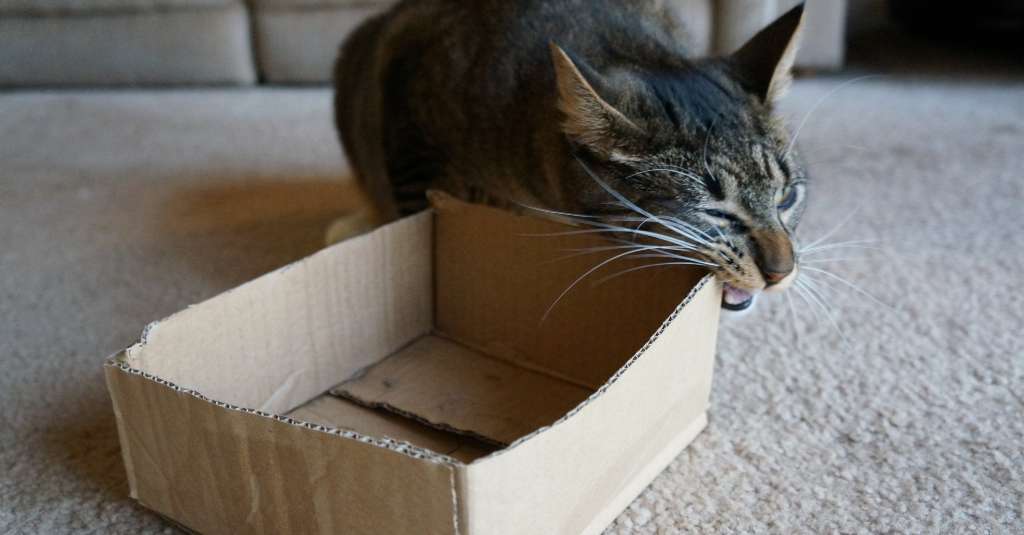
Dealing with unique feline behaviors, like Pica in cats, might seem perplexing, but fear not—this guide is here to shed light on the intricacies of your kitty’s habits. Like addressing any other condition, understanding Pica in cats is crucial for providing the best care for our furry friends.
Pica is not your everyday term, but when it comes to our feline friends, it refers to the peculiar habit of consuming non-nutritional items. From paper and plastic to wool and even electrical cords, some cats seem to have an adventurous palate that goes beyond their usual fare of kibbles and treats.
The reasons behind Pica can vary, and it’s essential to identify the root cause for effective management. Potential triggers include nutritional deficiencies, behavioral issues, medical conditions, or even environmental stressors. Understanding your cat’s lifestyle and potential stressors can play a significant role in determining the cause.
Spotting Pica in action involves observing your cat for telltale signs. Watch for vomiting, diarrhea, abdominal discomfort, or even the discovery of unusual items in the litter box. Changes in behavior, such as restlessness or lethargy, can also be indicators that your feline friend might be indulging in a bit of Pica. Behavioral changes, like increased vocalization or lethargy, can also be indicators. If you notice any of these signs, it’s time for a visit to the vet!
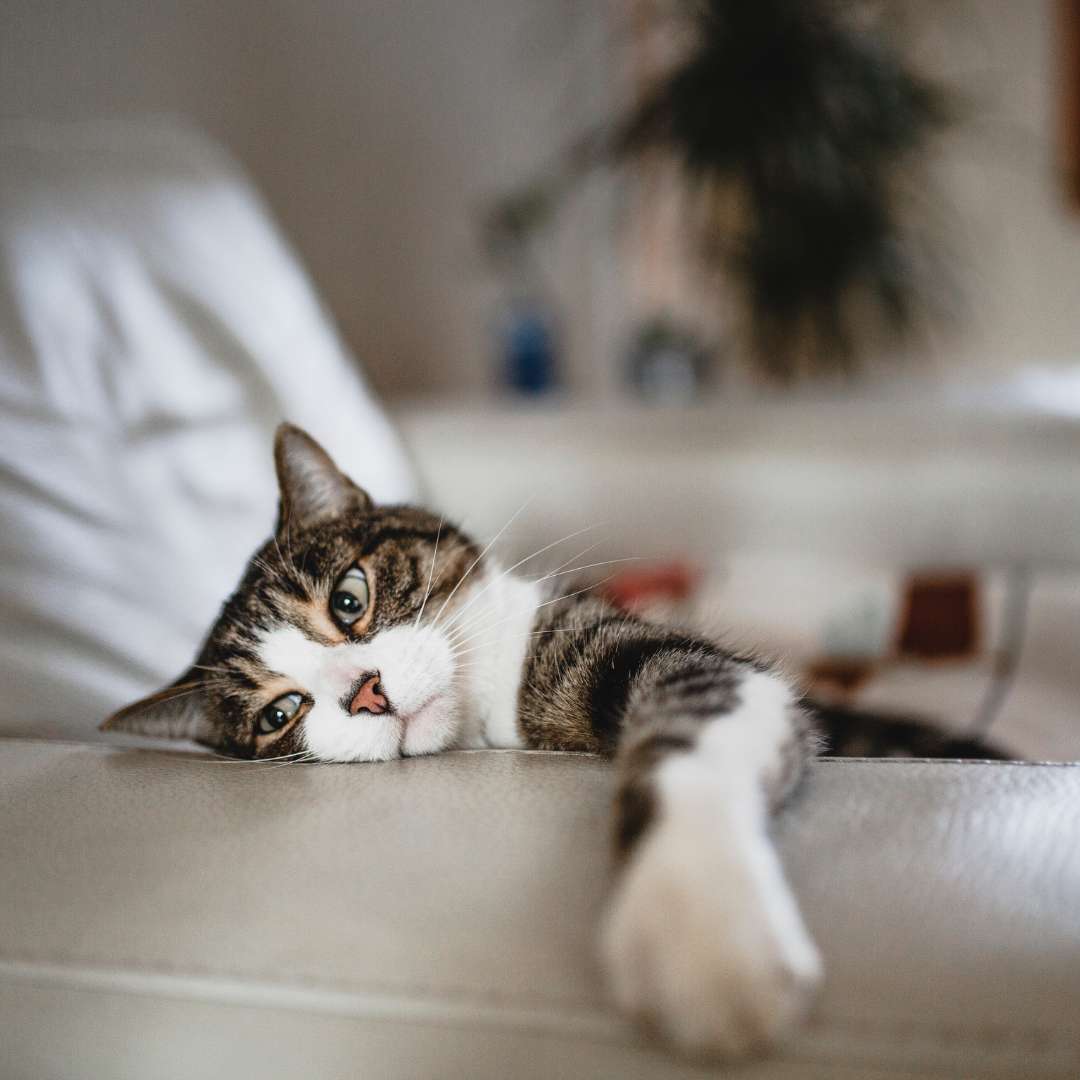
Pica in cats refers to the peculiar habit of consuming non-nutritional items.
When figuring out the root cause of Pica, your veterinarian may recommend diagnostic tests. Blood work, imaging studies, and sometimes even endoscopy might be on the agenda. These tests help rule out any underlying medical issues and guide the development of an appropriate treatment plan.
Treatment for Pica in cats depends on the underlying cause. If a nutritional deficiency is identified, dietary changes or supplements may be recommended. Behavioral issues might require environmental modifications or the introduction of interactive toys to keep your cat mentally stimulated. In some cases, medication may be prescribed to manage anxiety or compulsive behaviors.
Taking care of a cat with Pica involves a multi-faceted approach. First and foremost, follow your veterinarian’s recommendations for treatment. Additionally, consider making your home more cat-friendly by removing potential hazards and providing plenty of stimulating toys. Regular playtime and positive reinforcement can also help redirect their attention away from non-nutritional items.
NHV Supplement Support
At NHV, supplements like Multi Essentials and TumFlora may aid if your furbaby has Pica tendencies. Multi Essentials is our multivitamins that help your furbaby to be full of nutrients and vitamins, so if their Pica tendencies are due to lack of absorption of nutrients, Multi Essentials may come in handy. In the case of Tumflora, it helps to increase and improve the absorption of nutrients and make the gastrointestinal system healthier and stronger, also aiding in these cases where your furbaby is eating what it shouldn’t.
In the world of feline health, Pica may be an unexpected curveball, but armed with knowledge and the right veterinary guidance, you can ensure your cat leads a happy and healthy life. Keep an eye on their behavior, address any potential causes, and give them the love and care they deserve. After all, a little understanding goes a long way in creating a perfect environment for our beloved furballs! If you have any questions about Pica in cats or anything else, don’t hesitate to reach out to our experienced team of pet experts! We are here to help.
multivitamin support

Herbal Digestive Aid, Energy Booster, and Multivitamin for Cats
buy 2 and save $3
3 month supply for a small to medium size pet
These multivitamins for cats will ensure your kitty (of any age) is getting an extra dose of minerals and vitamins for extra energy, vitality, and health.


These multivitamins for cats will ensure your kitty (of any age) is getting an extra dose of minerals and vitamins for extra energy, vitality, and health.

The health benefits of multivitamins aren’t just for humans. Cats have many of the same nutrient needs as we do, and some need even more than others depending on their age and health.
A multivitamin supplies the vital nutrients your kitty needs to be healthy and to fight off potential health problems. Dr. Cook, DVM, CVA in her blog states that vitamins “help to regulate the body processes, protect the body from environmental toxins, and break down nutrients such as carbohydrates, proteins, and fats so the body can utilize them”.
The best way to give your cat vitamins and minerals are from whole food sources and not just isolated synthetic vitamins. NHV Multi Essentials contains a powerful blend of alfalfa, oat, dandelion, kelp, parsley, marshmallow, chickweed, stinging nettle, Asian ginseng, yucca and Oregon grape.
Health Benefits of NHV’s Multi-Essentials for Cats
With NHV’s multi vitamins for cats, you get a proprietary blend of all-natural ingredients that are organically grown and contain no artificial additives, preservatives, or coloring. Some of the health benefits include:
Multivitamins for cats will ensure your kitty is getting the proper nutrients that could be lacking due to daily stressors, a poor diet, and environmental toxins.
Signs of Vitamin Deficiency in Your Cat
Kitties Who’ve Benefited from NHV Multi Essentials
NHV multi vitamin for cats has helped thousands of pets around the world. Here are just a few of their stories:
DEALING WITH DIGESTIVE ISSUES: MICI THE CAT LOVES HIS VITAMINS NHV MULTI ESSENTIALS
HERBAL MULTIVITAMINS AND TURMERIC HELP CATS, OATMEAL AND MELISSA LIVE HAPPIER
CAN CATS WITH FELV LIVE A HEALTHY AND NORMAL LIFE?
If you have questions regarding holistic support including vitamin supplements for cats, ask an NHV expert because, at NHV, we want your cat to feel clawtastic naturally!
Select your pet's weight to determine the correct dose.
To be taken twice daily. Determine your pet’s weight and then use the easy chart below to determine the correct dose. This is the minimum dosage.
Pet's Weight Dosage
0 - 15 lb = 0.5 ml
16 - 30 lb = 1.0 ml
31 - 45 lb = 1.5 ml
46 - 60 lb = 2.0 ml
61 - 75 lb = 2.5 ml
Over 75 lb = 3.0 ml
How to Administer
Shake well before use. The easiest method is to use the dropper provide and places the drops into your pet’s food or favorite treat. You can also use the dropper and squirt directly into the pet’s mouth.
Some pets can be finicky, if this occurs consider hiding the drops in foods most pet’s love such as fish, chicken or yogurt or a favorite treat. If your pet only eats dry food then soak a few kibbles at feeding time.
For Best Results
Herbal dietary supplements are beneficial to the health and wellbeing of your pet and are safe for long-term use. Every pet responds to natural herbal supplements differently, therefore it is important to be consistent and administer the product daily. Supplements generally take two to four weeks to take effect, however this will vary from one animal to the next.
Product Storage
All NHV Natural Pet Products are pure herbal extracts and contain no artificial additives, preservatives or coloring. Shelf life after opening is 6 months and must be refrigerated after opening.
Cautions and Contraindications
Do not use Multi Essentials in pregnant or nursing animals. Speak to your vet before using our products. A second visit is recommended if your pet’s condition does not improve, or deteriorates after continued use of the supplements.
All information provided by NHV Natural Pet Products is for educational purposes only.
The health benefits of multivitamins aren’t just for humans. Cats have many of the same nutrient needs as we do, and some need even more than others depending on their age and health.
A multivitamin supplies the vital nutrients your kitty needs to be healthy and to fight off potential health problems. Dr. Cook, DVM, CVA in her blog states that vitamins “help to regulate the body processes, protect the body from environmental toxins, and break down nutrients such as carbohydrates, proteins, and fats so the body can utilize them”.
The best way to give your cat vitamins and minerals are from whole food sources and not just isolated synthetic vitamins. NHV Multi Essentials contains a powerful blend of alfalfa, oat, dandelion, kelp, parsley, marshmallow, chickweed, stinging nettle, Asian ginseng, yucca and Oregon grape.
Health Benefits of NHV’s Multi-Essentials for Cats
With NHV’s multi vitamins for cats, you get a proprietary blend of all-natural ingredients that are organically grown and contain no artificial additives, preservatives, or coloring. Some of the health benefits include:
Multivitamins for cats will ensure your kitty is getting the proper nutrients that could be lacking due to daily stressors, a poor diet, and environmental toxins.
Signs of Vitamin Deficiency in Your Cat
Kitties Who’ve Benefited from NHV Multi Essentials
NHV multi vitamin for cats has helped thousands of pets around the world. Here are just a few of their stories:
DEALING WITH DIGESTIVE ISSUES: MICI THE CAT LOVES HIS VITAMINS NHV MULTI ESSENTIALS
HERBAL MULTIVITAMINS AND TURMERIC HELP CATS, OATMEAL AND MELISSA LIVE HAPPIER
CAN CATS WITH FELV LIVE A HEALTHY AND NORMAL LIFE?
If you have questions regarding holistic support including vitamin supplements for cats, ask an NHV expert because, at NHV, we want your cat to feel clawtastic naturally!
Select your pet's weight to determine the correct dose.
To be taken twice daily. Determine your pet’s weight and then use the easy chart below to determine the correct dose. This is the minimum dosage.
Pet's Weight Dosage
0 - 15 lb = 0.5 ml
16 - 30 lb = 1.0 ml
31 - 45 lb = 1.5 ml
46 - 60 lb = 2.0 ml
61 - 75 lb = 2.5 ml
Over 75 lb = 3.0 ml
How to Administer
Shake well before use. The easiest method is to use the dropper provide and places the drops into your pet’s food or favorite treat. You can also use the dropper and squirt directly into the pet’s mouth.
Some pets can be finicky, if this occurs consider hiding the drops in foods most pet’s love such as fish, chicken or yogurt or a favorite treat. If your pet only eats dry food then soak a few kibbles at feeding time.
For Best Results
Herbal dietary supplements are beneficial to the health and wellbeing of your pet and are safe for long-term use. Every pet responds to natural herbal supplements differently, therefore it is important to be consistent and administer the product daily. Supplements generally take two to four weeks to take effect, however this will vary from one animal to the next.
Product Storage
All NHV Natural Pet Products are pure herbal extracts and contain no artificial additives, preservatives or coloring. Shelf life after opening is 6 months and must be refrigerated after opening.
Cautions and Contraindications
Do not use Multi Essentials in pregnant or nursing animals. Speak to your vet before using our products. A second visit is recommended if your pet’s condition does not improve, or deteriorates after continued use of the supplements.
All information provided by NHV Natural Pet Products is for educational purposes only.
Probiotic for Gut Health
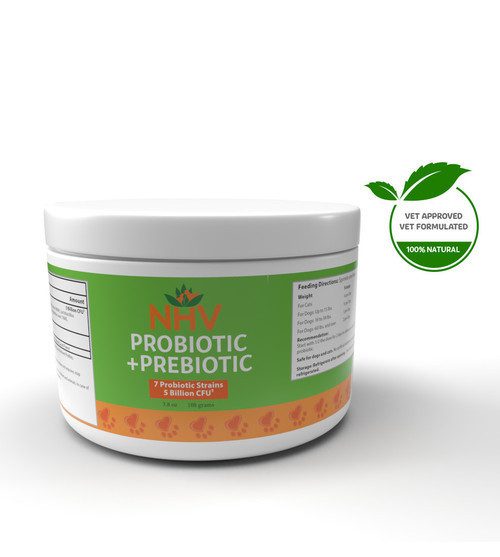
Vet-formulated. Helps with gut, immune, and anxiety support
buy 2 and save $3
4 month supply for a small to medium size pet.
Did you know your cat’s gut health is a key factor in their overall well-being? NHV Prebiotics + Probiotics for cats may be a valuable addition to your kitty’s regimen because it helps keep the GI tract healthy and, thus, contributes to your kitty’s overall health. The proprietary blend is designed and vet-formulated for your cat’s consumption. It contains 7 strains of human-grade probiotics, and each scoop has 5 Billion CFU (Colony Forming Units - amount of active good bacteria).


Did you know your cat’s gut health is a key factor in their overall well-being? NHV Prebiotics + Probiotics for cats may be a valuable addition to your kitty’s regimen because it helps keep the GI tract healthy and, thus, contributes to your kitty’s overall health. The proprietary blend is designed and vet-formulated for your cat’s consumption. It contains 7 strains of human-grade probiotics, and each scoop has 5 Billion CFU (Colony Forming Units - amount of active good bacteria).

Addressing potential concerns before they become a problem is always a good idea. As pet parents, the wellness of our sweet furkids is of the highest importance. Even when they don’t have any current health concerns, it's natural for us to seek proactive measures to maintain their optimal health. NHV supplements, like our Probiotics + Prebiotics for cats, may just be what you need.
This formula, containing 7 shelf-stable, soil-based, spore-forming probiotics, helps keep your kitty’s digestive system in tip-top shape. The probiotic strains include Bacillus coagulans LBSC, Bacillus subtilis PLSSC, Bacillus clausii 088AE, Lactobacillus acidophilus 033AE, Lactobacillus plantarum 022AE, Lactobacillus casei 118AE, and Saccharomyces boulardii SBSC.
Probiotics are formed by “good” bacteria and are well-known for improving digestive and cat gut health. These natural ingredients also help other aspects of your pet’s body work well and restore balance.
The live microorganisms, like bacteria and yeast, in probiotics can potentially restore gut microbiota, the natural microorganisms in a healthy gut. These beneficial bacteria are crucial in supporting the digestive tract and addressing digestive problems (e.g., IBS, diarrhea, constipation). Our vet added 7 strains of probiotics (5 Billion CFU per scoop) to help optimize gut health in different ways.
Their ability to add good bacteria to the pet’s body may help improve the immune system. These bacteria act as a defense mechanism against pathogens, potentially preventing the onset of significant diseases.
When the gut is swollen, it can make your cat more anxious or stressed. This happens because there are lots of nerves connecting the gut and the brain. So, a healthy gut is important for a happy and calm kitty.
Unlike probiotics, prebiotics are carbohydrates that induce the growth of good bacteria.
Our probiotic formulation is expertly formulated and has added pumpkin and carrot powder to help enhance absorption.
At NHV, we care. From sourcing and manufacturing to delivering the final products to your doorstep, our team ensures everything is done with the highest quality. What does it mean? It means that our formulations are all backed by research. And none of them contains any artificial additives, preservatives, or coloring. They're GMP-certified full-spectrum extracts made in an FDA-registered facility.
You can read more about how we formulate our products here.
Don’t worry. Even if your kitty is a picky eater, administrating NHV supplements is fairly easy. Since it is liquid-based, you can add the dosage to their daily meal favorite treat or directly squirt it in their cheek pocket.
If you have any questions about our probiotics supplement, your kitty’s gut health, or anything else in the world of pet wellness, please don’t hesitate to reach out!
Order NHV Prebiotics & Probiotics for Cats now to support your beloved sweetie’s health!
If your kitty is struggling with GI issues, you may also consider our TumFlora for Cats to help improve your cat’s natural intestinal flora and ease IBS symptoms.
In addition to natural supplements like ours, some foods contain rich probiotics. For example, plain, low-fat yogurt and fermented vegetables like kimchi are both recommended as probiotic-filled foods. However, before making any changes to your furkid’s diet, please remember to consult a vet first.
Probiotics
Prebiotics
Inactive Ingredients: Improve supplement absorption
For dogs: by weight
For cats: ¼ scoop per day. (SIX months supply)
How to Administer
Sprinkle over food. It is recommended to start with HALF the dose for 2 days to allow your little one to acclimate to the probiotic.
Product Storage
All NHV Natural Pet Products contain no artificial additives, preservatives, or chemicals. The shelf life after opening is SIX months, and must be refrigerated after opening.
Cautions and Contraindications: Do not use in pregnant or nursing animals. Speak to your vet before using our products. A second visit is recommended if your pet’s condition does not improve, or deteriorates after continued use of the supplements.
Addressing potential concerns before they become a problem is always a good idea. As pet parents, the wellness of our sweet furkids is of the highest importance. Even when they don’t have any current health concerns, it's natural for us to seek proactive measures to maintain their optimal health. NHV supplements, like our Probiotics + Prebiotics for cats, may just be what you need.
This formula, containing 7 shelf-stable, soil-based, spore-forming probiotics, helps keep your kitty’s digestive system in tip-top shape. The probiotic strains include Bacillus coagulans LBSC, Bacillus subtilis PLSSC, Bacillus clausii 088AE, Lactobacillus acidophilus 033AE, Lactobacillus plantarum 022AE, Lactobacillus casei 118AE, and Saccharomyces boulardii SBSC.
Probiotics are formed by “good” bacteria and are well-known for improving digestive and cat gut health. These natural ingredients also help other aspects of your pet’s body work well and restore balance.
The live microorganisms, like bacteria and yeast, in probiotics can potentially restore gut microbiota, the natural microorganisms in a healthy gut. These beneficial bacteria are crucial in supporting the digestive tract and addressing digestive problems (e.g., IBS, diarrhea, constipation). Our vet added 7 strains of probiotics (5 Billion CFU per scoop) to help optimize gut health in different ways.
Their ability to add good bacteria to the pet’s body may help improve the immune system. These bacteria act as a defense mechanism against pathogens, potentially preventing the onset of significant diseases.
When the gut is swollen, it can make your cat more anxious or stressed. This happens because there are lots of nerves connecting the gut and the brain. So, a healthy gut is important for a happy and calm kitty.
Unlike probiotics, prebiotics are carbohydrates that induce the growth of good bacteria.
Our probiotic formulation is expertly formulated and has added pumpkin and carrot powder to help enhance absorption.
At NHV, we care. From sourcing and manufacturing to delivering the final products to your doorstep, our team ensures everything is done with the highest quality. What does it mean? It means that our formulations are all backed by research. And none of them contains any artificial additives, preservatives, or coloring. They're GMP-certified full-spectrum extracts made in an FDA-registered facility.
You can read more about how we formulate our products here.
Don’t worry. Even if your kitty is a picky eater, administrating NHV supplements is fairly easy. Since it is liquid-based, you can add the dosage to their daily meal favorite treat or directly squirt it in their cheek pocket.
If you have any questions about our probiotics supplement, your kitty’s gut health, or anything else in the world of pet wellness, please don’t hesitate to reach out!
Order NHV Prebiotics & Probiotics for Cats now to support your beloved sweetie’s health!
If your kitty is struggling with GI issues, you may also consider our TumFlora for Cats to help improve your cat’s natural intestinal flora and ease IBS symptoms.
In addition to natural supplements like ours, some foods contain rich probiotics. For example, plain, low-fat yogurt and fermented vegetables like kimchi are both recommended as probiotic-filled foods. However, before making any changes to your furkid’s diet, please remember to consult a vet first.
Probiotics
Prebiotics
Inactive Ingredients: Improve supplement absorption
For dogs: by weight
For cats: ¼ scoop per day. (SIX months supply)
How to Administer
Sprinkle over food. It is recommended to start with HALF the dose for 2 days to allow your little one to acclimate to the probiotic.
Product Storage
All NHV Natural Pet Products contain no artificial additives, preservatives, or chemicals. The shelf life after opening is SIX months, and must be refrigerated after opening.
Cautions and Contraindications: Do not use in pregnant or nursing animals. Speak to your vet before using our products. A second visit is recommended if your pet’s condition does not improve, or deteriorates after continued use of the supplements.
digestive support
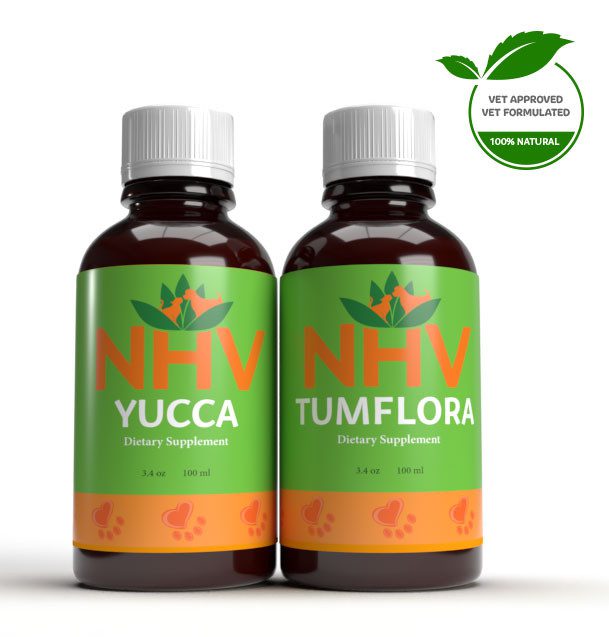
TumFlora & Yucca
bundle and save with pet expert kits
3 month supply for a small to medium size pet
Just like humans, our pets may be exposed to radiated food, toxins or antibiotics that may wipe out important gut flora that naturally lives in your pet’s digestive tract. When their GI tract is injured, your furkiddo may have a harder time absorbing vital nutrients. NHV’s Healthy Gut and Digestive Super Support Kit is a comprehensive bundle that helps to relieve inflammation and discomfort, aid healthy absorption, and helps to maintain proper gut health.


Just like humans, our pets may be exposed to radiated food, toxins or antibiotics that may wipe out important gut flora that naturally lives in your pet’s digestive tract. When their GI tract is injured, your furkiddo may have a harder time absorbing vital nutrients. NHV’s Healthy Gut and Digestive Super Support Kit is a comprehensive bundle that helps to relieve inflammation and discomfort, aid healthy absorption, and helps to maintain proper gut health.

As pet parents, it is never easy seeing our furbabies getting older and having difficulties with their health. As our pets age, they may need a little extra support to maintain their digestive health. Similar to dog probiotics or cat probiotics, our Healthy Gut and Digestive Super Support Kit is formulated to promote overall gastrointestinal health, aid digestion, and encourage a healthy appetite.
You've probably heard of the many health benefits of adding probiotics to support digestion and intestinal vitality. Just like probiotics, our Healthy Gut and Super Support Kit can help support and maintain your pet's digestion and intestinal tract.
This kit contains TumFlora and Yucca, two supplements that work together to help encourage healthy appetite, help improve bile flow, and aid effective absorption. Ingredients like chamomile and Oregon grape help to stimulate digestion by increasing bile flow and helping to relieve indigestion. The demulcent and anti-inflammatory properties soothe and soften irritated tissue to encourage healing.
Yucca contains many antioxidant properties that are beneficial for maintaining a healthy appetite and improving the absorption of essential vitamins and minerals.
Isn’t it nice to know that you can help support your pet’s digestive health naturally? Similar to cat and dog probiotics, our Healthy Gut and Digestive Super Support Kit is designed to help naturally maintain intestinal flora to promote a healthy gut and digestion. Apart from supplements, sometimes changing your pet’s diet may also greatly improve nutrient absorption and metabolism.
Made with the finest, organically grown, or ethically harvested herbs. Made specifically for pets, vet-formulated, and vet approved.
Ashwagandha &also known as Indian ginseng, is a root that contains antimicrobial, and anti-inflammatory properties that are beneficial for overall discomfort and combating infection.
Asian Ginseng – Helps increase energy levels and supports carbohydrate and lipid metabolism.
Boswelliahas been showing great promise in how it helps to alleviate symptoms of irritable bowel syndrome.
Chamomile – has traditionally been used to help with digestive issues including relieving vomiting, nausea, spasms and helping to improve bile flow (for better digestion).
Fennel – has anti-inflammatory properties which help to soothe the GI tract and promote healthy appetite.
Indian Gooseberry – has long been prized in Ayurvedic medicine for its many healing properties which include helping to reduce nausea, diarrhea and helping to reduce harmful cholesterol levels.
Licorice – has a long history of use for its immunostimulant, antimicrobial and anti-inflammatory properties to encourage effective digestion and overall vitality.
Marshmallow – is rich in calcium and contains demulcent properties to help soothe and protect the delicate intestinal lining. It also encourages the gentle detoxification of the gastrointestinal tract.
Oregon Grape - – contains anti-inflammatory, and anti-microbial properties that help relieve inflammation and help control infection in the digestive system.
Slippery Elm – is rich in antioxidant properties that help lubricate the throat and stomach. It is ideal support for pets living with gastritis, intestinal discomfort and diarrhea.
Yucca – Yucca root contains two compounds that are beneficial for improving nutrient absorption. It also contains vitamins (C, beta-carotene, B vitamins) and minerals (Mg, Fe, Ca, Mn, P) and niacin which promote a healthy appetite and help increase the bioavailability of food.
Select your pet's weight to determine the correct dose.
To be taken twice daily. Determine your pet’s weight and then use the easy chart below to determine the correct dose. This is the minimum dosage.
Pet's Weight Dosage
0 - 15 lb = 0.5 ml
16 - 30 lb = 1.0 ml
31 - 45 lb = 1.5 ml
46 - 60 lb = 2.0 ml
61 - 75 lb = 2.5 ml
Over 75 lb = 3.0 ml
For small animals (rabbits, ferrets), avians and reptiles use 1 drop for every 2 lb of body weight.
How to Administer
Shake well before use. The easiest method is to use the dropper provided and place the drops into your pet’s food or favorite treat. You can also use the dropper and squirt directly into the pet’s mouth. Some pets can be finicky, if this occurs consider hiding the drops in foods most pet’s love such as fish, chicken or yogurt or a favorite treat. If your pet only eats dry food then soak a few kibbles at feeding time.
For Best Results
Herbal dietary supplements are beneficial to the health and well-being of your pet and are safe for long-term use. Every pet responds to natural herbal supplements differently, therefore it is important to be consistent and administer the product daily. Supplements generally take two to four weeks to take effect, however this will vary from one animal to the next.
Product Storage
All NHV Natural Pet Products are pure herbal extracts and contain no artificial additives, preservatives or coloring. Shelf life after opening is 6 months and must be refrigerated after opening.
Cautions and Contraindications
Do not use in pregnant or nursing animals.
All information provided by NHV Natural Pet Products is for educational purposes only.
As pet parents, it is never easy seeing our furbabies getting older and having difficulties with their health. As our pets age, they may need a little extra support to maintain their digestive health. Similar to dog probiotics or cat probiotics, our Healthy Gut and Digestive Super Support Kit is formulated to promote overall gastrointestinal health, aid digestion, and encourage a healthy appetite.
You've probably heard of the many health benefits of adding probiotics to support digestion and intestinal vitality. Just like probiotics, our Healthy Gut and Super Support Kit can help support and maintain your pet's digestion and intestinal tract.
This kit contains TumFlora and Yucca, two supplements that work together to help encourage healthy appetite, help improve bile flow, and aid effective absorption. Ingredients like chamomile and Oregon grape help to stimulate digestion by increasing bile flow and helping to relieve indigestion. The demulcent and anti-inflammatory properties soothe and soften irritated tissue to encourage healing.
Yucca contains many antioxidant properties that are beneficial for maintaining a healthy appetite and improving the absorption of essential vitamins and minerals.
Isn’t it nice to know that you can help support your pet’s digestive health naturally? Similar to cat and dog probiotics, our Healthy Gut and Digestive Super Support Kit is designed to help naturally maintain intestinal flora to promote a healthy gut and digestion. Apart from supplements, sometimes changing your pet’s diet may also greatly improve nutrient absorption and metabolism.
Made with the finest, organically grown, or ethically harvested herbs. Made specifically for pets, vet-formulated, and vet approved.
Ashwagandha &also known as Indian ginseng, is a root that contains antimicrobial, and anti-inflammatory properties that are beneficial for overall discomfort and combating infection.
Asian Ginseng – Helps increase energy levels and supports carbohydrate and lipid metabolism.
Boswelliahas been showing great promise in how it helps to alleviate symptoms of irritable bowel syndrome.
Chamomile – has traditionally been used to help with digestive issues including relieving vomiting, nausea, spasms and helping to improve bile flow (for better digestion).
Fennel – has anti-inflammatory properties which help to soothe the GI tract and promote healthy appetite.
Indian Gooseberry – has long been prized in Ayurvedic medicine for its many healing properties which include helping to reduce nausea, diarrhea and helping to reduce harmful cholesterol levels.
Licorice – has a long history of use for its immunostimulant, antimicrobial and anti-inflammatory properties to encourage effective digestion and overall vitality.
Marshmallow – is rich in calcium and contains demulcent properties to help soothe and protect the delicate intestinal lining. It also encourages the gentle detoxification of the gastrointestinal tract.
Oregon Grape - – contains anti-inflammatory, and anti-microbial properties that help relieve inflammation and help control infection in the digestive system.
Slippery Elm – is rich in antioxidant properties that help lubricate the throat and stomach. It is ideal support for pets living with gastritis, intestinal discomfort and diarrhea.
Yucca – Yucca root contains two compounds that are beneficial for improving nutrient absorption. It also contains vitamins (C, beta-carotene, B vitamins) and minerals (Mg, Fe, Ca, Mn, P) and niacin which promote a healthy appetite and help increase the bioavailability of food.
Select your pet's weight to determine the correct dose.
To be taken twice daily. Determine your pet’s weight and then use the easy chart below to determine the correct dose. This is the minimum dosage.
Pet's Weight Dosage
0 - 15 lb = 0.5 ml
16 - 30 lb = 1.0 ml
31 - 45 lb = 1.5 ml
46 - 60 lb = 2.0 ml
61 - 75 lb = 2.5 ml
Over 75 lb = 3.0 ml
For small animals (rabbits, ferrets), avians and reptiles use 1 drop for every 2 lb of body weight.
How to Administer
Shake well before use. The easiest method is to use the dropper provided and place the drops into your pet’s food or favorite treat. You can also use the dropper and squirt directly into the pet’s mouth. Some pets can be finicky, if this occurs consider hiding the drops in foods most pet’s love such as fish, chicken or yogurt or a favorite treat. If your pet only eats dry food then soak a few kibbles at feeding time.
For Best Results
Herbal dietary supplements are beneficial to the health and well-being of your pet and are safe for long-term use. Every pet responds to natural herbal supplements differently, therefore it is important to be consistent and administer the product daily. Supplements generally take two to four weeks to take effect, however this will vary from one animal to the next.
Product Storage
All NHV Natural Pet Products are pure herbal extracts and contain no artificial additives, preservatives or coloring. Shelf life after opening is 6 months and must be refrigerated after opening.
Cautions and Contraindications
Do not use in pregnant or nursing animals.
All information provided by NHV Natural Pet Products is for educational purposes only.
Published: February 1, 2024